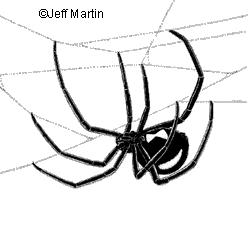Black Widow Spider
Latrodectus hesperus
Family: Theridiidae
Other common names: western black widow
Spanish name: viuda negra
Description
The female of this sexually dimorphic species is usually ¼ to ¾ inch (12 to 19 mm) in body length, shiny black or very dark brown, with a large rounded or oval abdomen which is characterized by a bright red-orange hourglass shape on the underside. The male is less than half the size of the female, medium brown with cream-colored markings on legs and abdomen. The young of both sexes resemble the male.
Distribution and Habitat
Different species of Latrodectus are found throughout most of North America, more commonly in warmer climates. Black widows are common around man-made structures such as garages, lawn furniture, and woodpiles. They also live in a variety of natural habitats.
Ecology
 |
The black widow preys mainly upon insects that it traps in the web. The web is irregular and strong to the touch in comparison to other webs. Some species of spider wasps prey upon black widows. Black widows are shy, sedentary, and largely nocturnal. They are not aggressive, but will bite in self-defense.
Life History
The female mates only once in her lifetime, retaining sperm for future egg-laying. The smaller male is sometimes eaten by the female following mating, hence the name “widow.” This characteristic, however, is not limited to black widows, but can occur after mating in many arachnids, most of which are highly predatory. The female lays approximately 300 eggs at one time and encases them in a round, cream-colored egg sac made of her silk. One spider produces several sacs within its one- to two-year lifespan, but only one sac at a time. The spiderlings disperse by ballooning.
The black widow is one of two species within our region that is potentially dangerous to humans (the brown spider is the other). The bite can kill a human, but this is rare. More often, the bite is painful and causes serious reactions, including nausea, dizziness and abdominal cramps.










